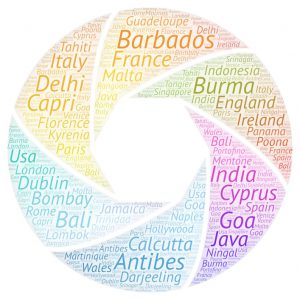‘In 1938 Athole Hay my husband died, and I got rid of the house and went to Tangier…’
The above quote opens the first page of Silvia’s book (AL). It is one of the few mentions of her husband, whose death caused her world to collapse. Her mother too had just died and her brother was far away in India. Aware of war looming, and of artists/refugees escaping from Germany, she chose to escape as well.
Silvia departs from Southampton on the 8th April 1938 on ‘Sibajar’ (Royal Dutch mail ship) for Tangier and is described as an ‘artist-explorer’. She was in search of somewhere to settle down but never really succeeded. Her loneliness and anxiety is evident on many pages, as is her sharp eye which notices beauty in nature; this provides an important source of solace for her. Wordsworth’s poem ‘I wandered lonely as a Cloud’ is an appropriate expression of her sentiments. Silvia’s ‘host of daffodils’ were later found in Bali – a place against which most other places that she visited were compared.
Her journey takes a year longer than T S Eliot’s Quartet publication (1938-43), written when he too was suffering loss, loneliness and spiritual search. The Four Quartets was the last great work TSE composed – set against a background of imminent and actual world war, it is a series of meditations on the relationship between time and humanity. Silvia’s travelogue is sub-titled: Pages from an Artist’s travel-diary. But like Eliot, they are a series of musings on the relationship between time and space. On the fly sheet for her later book (JY), she suggests that ‘one of the charms of travel is that we move in Time as well as in Space. Weary of Today… we can sometimes escape to half-medieval countries … like Spain and Cyprus or to enchanted islands in the Pacific…’
Silvia inherited a small amount of money and used dividends to pay for her travel, along with some teaching, but was always running short of cash. Wherever she went, however, she drew portraits, of local indigenous people – fishermen, a pantry maid, old woman, dancers, musicians… Alongside these paintings, she presents a collage of stories and anecdotes, heard or experienced along the way. In the Introduction, Williams-Ellis comments that the author is primarily a painter so that her ‘text is the sound-track accompaniment to her pictures’. He describes Silvia as a ‘sympathetic and gentle ironic castaway’.
Around The World...

California – Panama, Los Angeles/Hollywood
South Asia – Bali, Lombok, Java, Singapore, Rangoon
India – Criss-crossed the sub-continent
Caribbean – Jamaica, Trinidad, Martinique, Guadeloupe, Barbados
South Pacific – Tahiti (French Polynesia)
Europe – Malta, France, Italy, Cyprus, Spain
Notes: In the following Travel Pages, the quotes in italics have been chosen to help paint a picture of Silvia as a character, rather than as an author but, of course, the selection is subjective and subject to interpretation.
Most of the images are taken from her two books, based on her diaries which we don’t have – they were probably thrown out long ago. The books are more like travel journals; neither of them is a literary masterpiece but they provide much needed clues as to when and where she went.
AL = Alone & Loitering (1946)
JY = Journey to Yesterday (1950)
(See: Author Page for further details on both books)
Photo images are held in family collections.
Old place names which Silvia used are usually employed, eg Calcutta instead of Kolkata.
